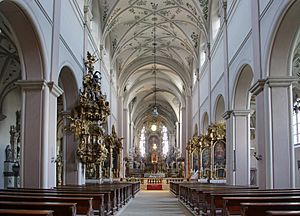St Michael's Church, Bamberg facts for kids
The Michaelskirche (which means Church of St Michael) in Bamberg is a very old church from the 12th century. It stands on top of a very high hill that looks over the town of Bamberg. You can see it from almost everywhere! Bamberg is built on seven hills, and each one has a special building on its peak. The hill where St Michael’s Church stands is the highest one. An old, cobbled road with some ancient houses leads from the cathedral up to the church. Not far past the church, you will find fields and woods.
The church is built in the Romanesque style. This is an old way of building with thick walls and round arches. It used to be the church for a Benedictine monastery. The monastery stopped being a religious place in 1803. Today, there is a home for older people there, along with a museum and city art collections.
The Story of St Michael's Church
Emperor Heinrich II (Henry II) started the Bishopric of Bamberg. The first bishop of Bamberg was Eberhard. He founded the abbey of St Michael. An abbey is a type of monastery. This abbey belonged to the bishop. The abbot, who was the head monk, had to obey the bishop. The monks who came to live there traveled from the towns of Amorbach and Fulda.
In the 12th century, the abbey became very successful. This was when Otto of Bamberg was the bishop. The abbey started to become more independent from the bishop.
The abbey faced difficult times during the wars around 1525. But in the 17th and 18th centuries, things got better again. When the bishops lost their political power in 1803, the abbey became part of the town. People asked for the homes for the poor in the town to be moved to the St Michael abbey. There is still a home for older people there today.
What's Inside the Church
Behind the main altar is the tomb of Bishop Otto of Bamberg. This tomb was made in 1443. It has a hole in the middle that is just big enough for a person to crawl through. Visitors to the church like to crawl through this hole. People say it helps those who have backache feel better!
The roof of the nave, which is the main part of the church, is very special. It has paintings of 580 different kinds of plants. These include plants from faraway countries, like pineapple, cotton, pomegranate, and tobacco. There are also paintings of plants found nearby. These paintings were made in the 17th century. Many of these plants were grown in the herb gardens around the church.
In the side aisles of the church, the ceiling has even more paintings. These include paintings of birds. You can even spot six parrots among them!






